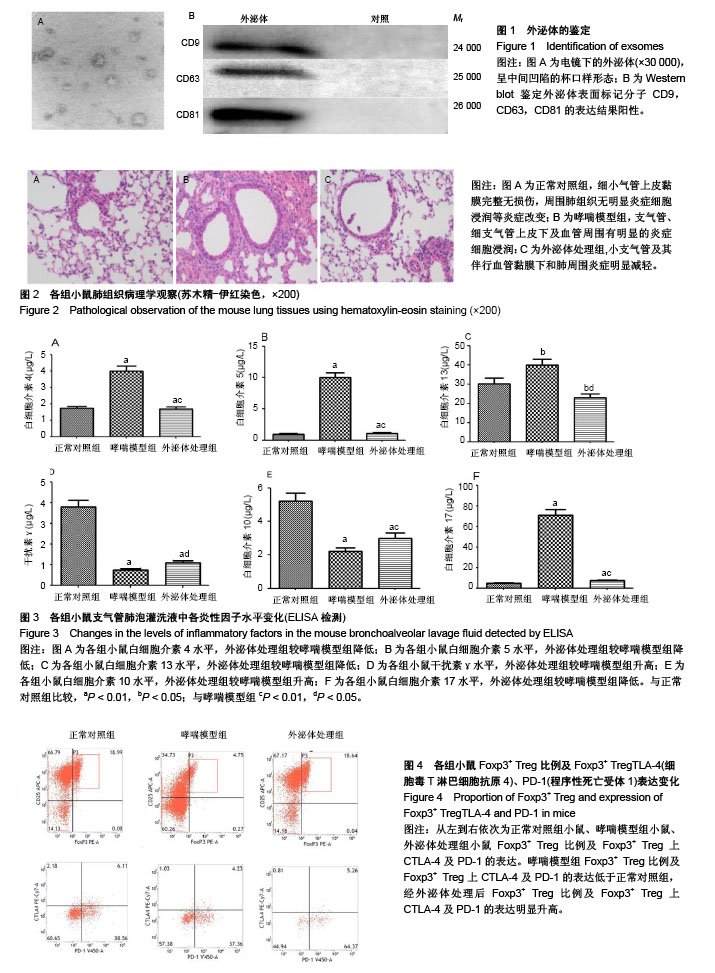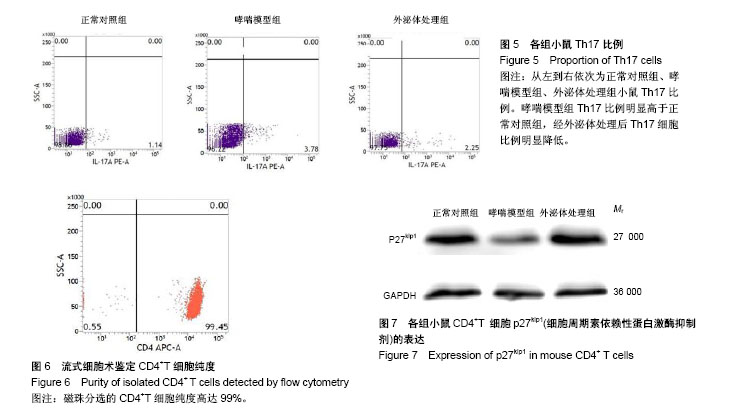| [1] Lambrecht BN, Hammad H. The immunology of asthma. Nat Immunol. 2014;16(1):45-56.[2] Martinez FD, Vercelli D. Asthma. Lancet. 2013;382(9901): 1360-1372.[3] 李建国,颛孙永勋,冉丕鑫,等.骨髓间充质干细胞对哮喘小鼠CD4+ CD25+ 调节性T细胞及气道炎症的影响[J].中国组织工程研究与临床康复,2008,12(47):9302-9305.[4] Kitazawa Y, Fujino M, Wang Q, et al. Involvement of the Programmed Death-1/Programmed Death-1 Ligand Pathway in CD4+ CD25+ Regulatory T-Cell Activity to Suppress Alloimmune Responses. Transplantation. 2007;83(6):774-782.[5] Chen W, Huang Y, Han J, et al. Immunomodulatory effects of mesenchymal stromal cells-derived exosome. Immunol Res. 2016;64(4):831-840.[6] Braga WM, Da SB, de Carvalho AC, et al. FOXP3 and CTLA4 overexpression in multiple myeloma bone marrow as a sign of accumulation of CD4(+) T regulatory cells. Cancer Immunol Immunother. 2014;63(11):1189-1197.[7] Kataoka H, Takahashi S, Takase K, et al. CD25(+)CD4(+) regulatory T cells exert in vitro suppressive activity independent of CTLA-4. Int Immunol. 2005;17(4):421-427. [8] Afzali B, Lombardi G, Lechler R I, et al. The role of T helper 17 (Th17) and regulatory T cells (Treg) in human organ transplantation and autoimmune disease. Clin Exp Immunol. 2007; 148(1):32-46.[9] Mao F, Wu Y, Tang X, et al. Human umbilical cord mesenchymal stem cells alleviate inflammatory bowel disease through the regulation of 15-LOX-1 in macrophages. Biotechnol Lett. 2017; 39(6):929-938.[10] Uccelli A, Moretta L, Pistoia V. Mesenchymal stem cells in health and disease. Nat Rev Immunol. 2008;8(9):726-736. [11] Akiyama K, Chen C, Wang D, et al. Mesenchymal-stem- cell-induced immunoregulation involves FAS-ligand-/FAS- mediated T cell apoptosis. Cell Stem Cell. 2012;10(5):544-555. [12] Eirin A, Riester SM, Zhu X, et al. MicroRNA and mRNA cargo of extracellular vesicles from porcine adipose tissue-derived mesenchymal stem cells. Gene. 2014;551(1):55-64. [13] de Castro LL, Xisto DG, Kitoko JZ, et al. Human adipose tissue mesenchymal stromal cells and their extracellular vesicles act differentially on lung mechanics and inflammation in experimental allergic asthma. Stem Cell Res Ther. 2017;8(1):151.[14] 颛孙永勋,张炜,杜雨末,等.间充质干细胞对去除CD4-+CD25-+调节性T细胞哮喘小鼠气道炎症的影响[J].中国组织工程研究, 2017, 21(5):742-747.[15] Li Y, Li H, Cao Y, et al. Placentaderived mesenchymal stem cells improve airway hyperresponsiveness and inflammation in asthmatic rats by modulating the Th17/Treg balance. Mol Med Rep. 2017;16(6):8137-8145. [16] Kitoko JZ, de Castro LL, Nascimento AP, et al. Therapeutic administration of bone marrow-derived mesenchymal stromal cells reduces airway inflammation without up-regulating Tregs in experimental asthma. Clin Exp Allergy. 2018;48(2):205-216. [17] Breitbach M, Bostani T, Roell W, et al. Potential risks of bone marrow cell transplantation into infarcted hearts. Blood. 2007; 110(4):1362-1369.[18] Jeong JO, Han JW, Kim JM, et al. Malignant Tumor Formation After Transplantation of Short-Term Cultured Bone Marrow Mesenchymal Stem Cells in Experimental Myocardial Infarction and Diabetic Neuropathy. Circ Res. 2011;108(11):1340-1347.[19] Cruz FF, Borg ZD, Goodwin M, et al. Systemic Administration of Human Bone Marrow-Derived Mesenchymal Stromal Cell Extracellular Vesicles Ameliorates Aspergillus Hyphal Extract-Induced Allergic Airway Inflammation in Immunocompetent Mice. Stem Cells Transl Med. 2015,4(11): 1302-1316. [20] Xu L, Li J, Zhang Y, et al. Regulatory effect of baicalin on the imbalance of Th17/Treg responses in mice with allergic asthma. J Ethnopharmacol. 2017;208:199-206. [21] Zongyi Y, Funian Z, Hao L, et al. Interleukin-35 mitigates the function of murine transplanted islet cells via regulation of Treg/Th17 ratio. PLoS One. 2017;12(12):e189617. [22] Kinoshita T, Baatjes A, Smith SG, et al. Natural regulatory T cells in isolated early responders compared with dual responders with allergic asthma. J Allergy Clin Immunol. 2014;133(3):696-703. [23] Chauhan A, Singh M, Agarwal A, et al. Correlation of TSLP, IL-33, and CD4+ CD25+ FOXP3+ T regulatory (Treg) in pediatric asthma. J Asthma. 2015;52(9):868-872. [24] Kawayama T, Kinoshita T, Matsunaga K, et al. Role of Regulatory T cells in Airway Inflammation in Asthma. Kurume Med J. 2018; 64(3):45-55. [25] Asano T, Meguri Y, Yoshioka T, et al. PD-1 modulates regulatory T-cell homeostasis during low-dose interleukin-2 therapy. Blood. 2017;129(15):2186-2197. [26] Wang W, Lau R, Yu D, et al. PD1 blockade reverses the suppression of melanoma antigen-specific CTL by CD4+CD25Hi regulatory T cells. Int Immunol. 2009;21(9):1065-1077.[27] Klocke K, Holmdahl R, Wing K. CTLA-4 expressed by FOXP3(+) regulatory T cells prevents inflammatory tissue attack and not T-cell priming in arthritis. Immunology. 2017;152(1):125-137. [28] Tsuji S, Kimata T, Yamanouchi S, et al. Regulatory T cells and CTLA-4 in idiopathic nephrotic syndrome. Pediatr Int. 2017; 59(5): 643-646.[29] Iglesias M, Postigo J, Santiuste I, et al. p27Kip1inhibits systemic autoimmunity through the control of Treg cell activity and differentiation. Arthritis Rheum. 2013;65(2):343-354. |
.jpg)



.jpg)